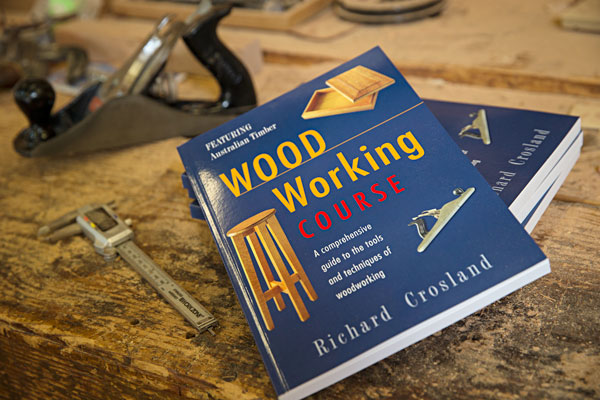Author: Richard Crosland
First published: 1996
Pages: 184
Softcover
Black and white, with colour plate section
Books on woodworking technique by Australian authors are few and far between. Well known Sydney woodworker and woodwork teacher Richard Crosland is one of the few, and has in fact been a trailblazer in this regard.
Richard Crosland established his woodworking school in 1978 and had already been teaching for 20 years before publishing the book. With that experience he was well equipped to know exactly the sort of information beginners need, and how to best present it.
In the early 90s Richard was invited by publishers Simon and Schuster to write a book after they saw him presenting on a TV how-to segment. Woodworking Course was eventually published in 1996 and recently, following a lot of good feedback over the years, and many requests since the book went out of print, a third reprinting has just been released.
I asked Richard how long it took to write it way back then. ‘Far too long’, Richard said. ‘It got to the point where I’d passed so many deadlines that the publisher rang me up one day and said, “Either you bring me in your manuscript by next Friday, or the whole thing’s off.”’ Fortunately Richard did get the book finished in time and since then over 10,000 copies have been sold.
The style of the book is open and inclusive, no prior knowledge of woodworking techniques or tools is assumed. ‘When I was writing the book I said to myself if this is going to be a how-to book, I’ve really got to explain things. It’s not going to be a book where it says “Dress your timber to such-and-such a thickness and such-and-such a width and then leave it at that’, said Richard. ‘I questioned myself all through the book making sure there were explanations for every instruction.’
In the first part of the book, Richard covers basic workshop, hand tool and hardware needs. He also discusses wood and manmade products explaining fundamental concepts of buying and selecting.
The second part deals with ‘Practical Considerations’, including dressing wood, veneering, sharpening, and hand tool and machine usage.
The rest of the book features seven projects that are geared to the early discovery and practice of basic techniques. These include a pot plant stand, small box, stool, bookcase, coffee table, blanket box and dining table.
The book is mostly in black and white with line drawings throughout, although there is a section of colour photos that features the tools, machinery and projects discussed in the book.
No one book can cover everything to do with all the often complex facets of woodworking, for that a teacher is the best solution, however this book is an excellent introduction and reference for the beginner.
Richard and Adam Crosland teach regular classes at Richard Crosland School of Fine Woodwork in Alexandria, Sydney. Phone 02 9313 4142 or email richard@crosland.com.au. More information at www.crosland.com.au





